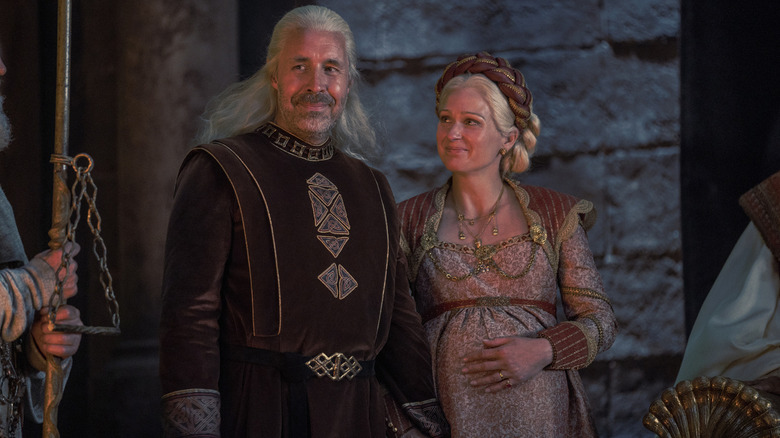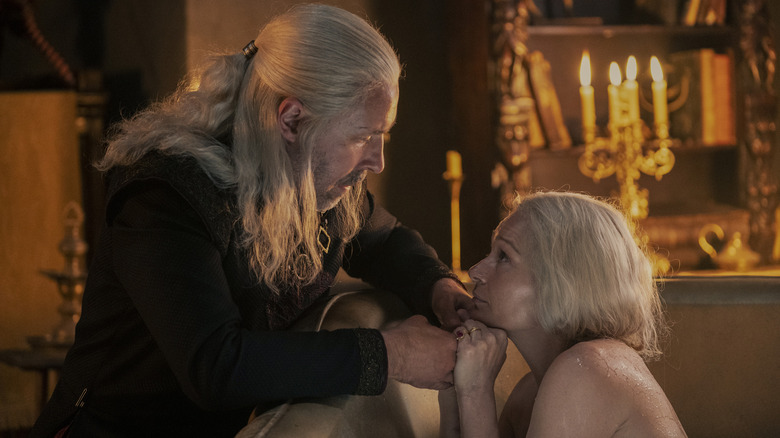How The Ickiest Part Of House Of The Dragon Is Steeped In Real History
There are a lot of potentially problematic elements in "Game of Thrones" and its spin-off series, "House of the Dragon," but perhaps the ickiest of them all is the rampant incest. The Targaryen dynasty is rife with cosanguinity, which is a fancy word for inbreeding, and the practice is clearly still in fashion in "House of the Dragon," as King Viserys Targaryen (Paddy Considine) and Queen Aemma Arryn (Sian Brooke) are first cousins. They share a set of Targaryen grandparents, Jaehaerys I and his sister-wife Alysanne, so they both have some of that lovely double-dragon bloodline going on. Fans of the George R.R. Martin novel that "House of the Dragon" is based on know that the married cousins are not the last incestuous relationship in the story, because Targaryens are really all about keeping it in the family.
"House of the Dragon" is set in a fantasy world, but marriages between siblings, cousins, and other close family members have been a surprisingly common occurrence among royalty throughout history. There were practical and political reasons behind such marriages, and the potential genetic problems that could result from repeat inbreeding hadn't really been figured out yet. Let's dig into the Targaryen practice and the historical families that inspired their concerning custom.
Incest in ancient times
Some of the most prolific practitioners of siblings parenting children together lived during the classical era, in the dynasties of the Egyptian pharaohs and of some Roman emperors. The "boy king" Tutankhamun was definitely the product of incest, as the Egyptian kings were thought of as living avatars of the gods, and the gods married their siblings. King Tut's father, the radical Akhenaten who tried to convert Egypt to monotheism under the son god Aten, was married to the legendary beauty Nefertiti, but later married his own sister as well when Nefertiti did not bear him any children. Tut is the child of this union, and scientists have found several genetic abnormalities from his mummified corpse that likely resulted from generations of dipping back into the same exact gene pool. The famous queen Cleopatra was also the child of a brother-sister union, and later married both of her own younger brothers.
The most famous stories of incest in Ancient Rome come from the family of Emperor Caligula, who has been remembered for both his fiery passion and his madness. While many historians now believe that rumors of Caligula having sex with his three sisters were largely fabricated by his enemies, his sister, Agrippina the Younger, did marry her uncle, the emperor Claudius. There are also plenty of rumors about her having an affair with her son Nero, who later became emperor as well. Caligula, Agrippina, and Nero are all clear inspirations for the Targaryens, who are half brilliant and half mad. After all, Nero was accused of enjoying the fact that Rome burned to the ground, and if that's not the most Targaryen thing on this planet, then what is?
Messy medieval marriages
In slightly more recent history, the medieval dynasties of Europe were pretty laden with their own incest issues, most notably the Habsburgs. This massive family's Spanish branch started twisting in on itself through political marriages between close relatives, and they continued this practice for nearly 200 years. Unfortunately, all of this inbreeding led to the family reinforcing some troublesome recessive genes, and the dynasty died out when Charles II, who suffered from an over-sized tongue, malformed jaw, and infertility, died at the age of 38. You would think that watching that kind of downward spiral in an uncomfortably close-knit family would prevent future generations from practicing incest, but Queen Victoria of England married her first cousin in 1840, with potentially disastrous consequences.
The Targaryens seem to marry their siblings for reasons closer to the Egyptians, as they believe they are touched by the dragons, but there are elements of other real-world royal families in their makeup as well. The Targaryens suffer from what they think is a curse that renders many of them mad, but it could really just be as simple as a recessive gene run wild (along with a healthy dose of royal entitlement).
Of course, the Targaryens aren't the only family in the "Game of Thrones" universe to dabble in sibling-diddling, because Cersei and Jaime Lannister are also quite smitten despite being twins. Cersei even tries to use the Targaryens to justify it, though they never get away with their forbidden fling as well as the dragon-riders did.
New episodes of "House of the Dragon" premiere Sundays on HBO and HBO Max.


